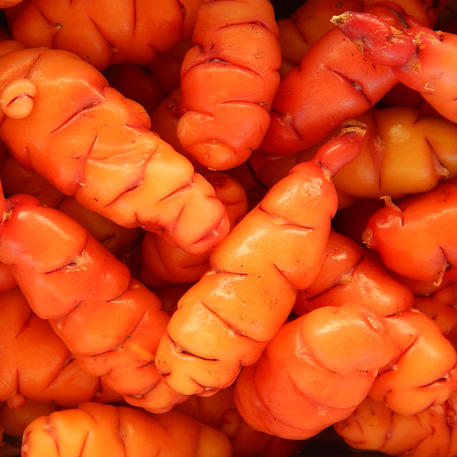-
Filter By Stock
- In Stock (0)
NEW ZEALAND YAM
BOTANICAL NAME: Oxalis tuberosa
COMMON NAMES: New Zealand Yam; Truffette Acide; Papa Roja; Quiba; Ibias; Knollen-Sauerklee, Uqa, Oca
FAMILY: Oxalidaceae, the oxalis or wood sorrel family
ORIGIN: The plant was brought into cultivation in the central and southern Andes
PLANT DESCRIPTION
A compact, attractive, bushy perennial plant with clover-like leaves to 20 - 30 cm high producing tubers which look like stubby, wrinkled grubs. It is suited to some temperate areas and will tolerate high altitudes. It is definitely not suitable to subtropical or tropical climates over summer. The plants are resistant to low temperatures and thrive in moderately cool climates but freezing will kill the foliage. If the tubers are already established it will re-sprout. Temperatures above 28°C will cause the plant to wilt. Tubers start forming 4 months after planting and production peaks at 6 months. Plants will tolerate a wide range of soil types and pH.
USES
Oca uses are similar to a potato i.e. oca can be boiled, baked or fried. In Mexico, oca is commonly sprinkled with salt, lemon and hot pepper and eaten raw. It is also made into pickles with vinegar. The traditional Andean preparation method for NZ Yam is exposing the tubers to sunlight, which decreases the acid content and increases the sweet taste of the tubers. Once exposed to sunlight, the tubers can be boiled, baked or fried. In the Andes it is used in stews and soups, served like potatoes, or may be served as a sweet.
While the plant is cultivated primarily for its edible tubers, the leaves and young shoots can also be eaten as a cooked green vegetable similar to spinach. Mature stems can be used similarly to rhubarb.
Mature plants and tubers may also be used as pig forage.
PLANTING GUIDE
The recommended planting time is spring in cool areas and at the beginning of the wet season in warmer areas. To plant cover the tubers with soil to a depth of 5 cm; space plants 30 cm apart. NZ Yam plants should be hilled like potatoes to encourage tuber formation, at about 4 months. The plant is easy to grow due to its easy propagation and tolerance for poor soil, high altitude and harsh climates.
When the tubers are mature, the foliage will start to die back. Tubers are more perishable than potatoes, but if properly handled can be stored at room temperature for some months. Store the best tubers for propagation the next season in dry sand or sawdust, in a cool dark place.
COMPANION PLANTS
LIKES: Oregano, Dill,

NEW ZEALAND YAM (10 Tubers)
***NOT TO TAS, WA*** (Oxalis tuberosa) Originating from the Andean Highlands & first introduced onto the market in England in 1829. Also known as
$12.95
